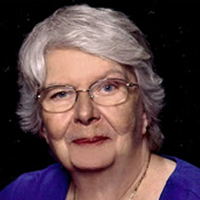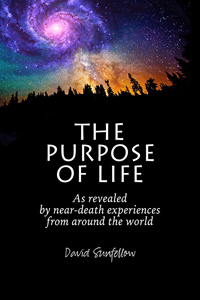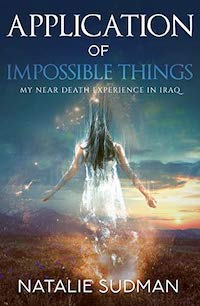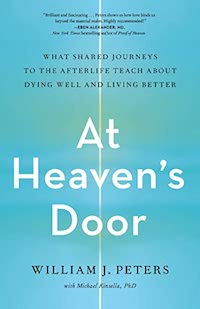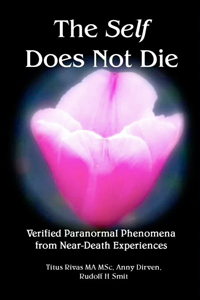![]()
Nancy Evans Bush
Nancy Evans Bush has a BA in English is from the University at Albany-SUNY, and a master’s degree in Pastoral Ministry from St. Joseph College in Connecticut, with additional graduate study at Trinity College and the University of Connecticut. She has three children, seven grandchildren and one great-grandchild. Nancy is a past-president of The International Association for Near-Death Studies, Inc. (IANDS) and because of her own distressing near-death experience, has been their go-to researcher on distressing NDEs for 30 years.
Website & Background Information
• Dancing Past The Dark
• Nancy Evans Bush on Twitter
• Nancy Evans Bush (includes ability to download)
Book
Dancing Past the Dark: Distressing Near-Death Experiences (2012)
…………
[youtube]https://www.youtube.com/watch?v=jmaDvT2G_g0[/youtube]
…………
[youtube]http://www.youtube.com/watch?v=HgsiiqVok8U[/youtube]
…………
[youtube]http://www.youtube.com/watch?v=8Gghhqcu-Es[/youtube]
Presented at the IANDS 2012 Conference, Aug. 31-Sept. 2, in Scottsdale, AZ
Abstract: The conventional understanding of hell is as a place of eternal torment after death. This view, which is generally believed to be historical and biblical, colors the publicÕs interpretations of distressing NDEs, producing enormous fear or outright rejection of the entire concept of hellish experiences. A review of the roots of Western hell shows that the familiar concept is neither historically stable nor biblically accurate. How, then, can hellish visions be interpreted? I contrast the conventional literal/materialistic understanding (external, factual, time-space orientation) with a symbolic/spiritual interpretation (internal, imaginal, occurring in mythic timelessness). By de-literalizing and reframing the interpretation of common hellish symbols (e.g., fire, snakes,monsters), such an experience can be understood as precipitating a developmental thrust, rather than as a vision of punitive torment. This approach opens the most distressing NDEs to being understood as intensely personal events that nonetheless share in the great Mystery of the human unconscious. It can be read in both religious and secular terms.
…………
REFLECTIONS FROM THREE DECADES WITH IANDS
Nancy Evans Bush Interviewed by Amy Stringer
From the Fall 2009 edition of “Vital Signs”
The newsletter of The International Association for Near-Death Studies, Inc.
Download the complete interview with Nancy here (pdf)
EXCERPT:
VS: Please tell us about your own NDE which you had during childbirth.
NEB: It was not a radiant experience; it was an utterly terrifying experience of the void. I had never heard of anything like it. I didn’t know anybody else in the world had ever had such an experience. That left me with a sense that I was walking around with secret knowledge too terrible to tell anybody.
There was a group of circles. They were clicking, black to white, white to black. They weren’t…I didn’t think they were evil, but they were malicious, maybe the way a sibling would be malicious when you’re being really heartless to each other. There was no question: they were authoritative. They knew stuff I did not know. I was the stranger there; they weren’t. It never occurred to me that this was hell, and it never occurred to me that I was dead, only that this was what it would probably be like when I was dead. I just knew that this was a place other than where I thought I had been.
I was told I did not exist. I had never existed. It had been a joke. My life was a joke; my baby’s life was a joke. I had a 17-month-old daughter; she did not exist. My mother did not exist. Hills, trees, robins, Earth did not exist. It was so utterly clear I was being told something true. It’s hard to explain …what would have been the point of arguing? What they were saying was incontrovertibly true.
[I had] no context for it. The Christianity I grew up with was a pretty amiable theology — Congregational UCC, God is love, and Jesus loves the little children. My father and grandfather were ministers from a very liberal, intellectual tradition. Oh, some people talked about hell, but we knew that God loves his people, and if you try to do the right thing, you’ll be all right.
When I woke up my first conscious thought was, “Calvin was right…predestination.” There are sheep, and there are goats, and I must be a goat; some people are just automatically on the outs with God. And, the reason that occurred to me was because it was so contrary to anything I thought I deserved.
Most of the people who have written about unpleasant experiences talk about them as happening to people who were sin-ridden, guilt-ridden, hostile, God-denying, love denying, suicidal -– all of that. None of which applied to me. I was far from perfect, but for heaven’s sake, I had been saved twice at Billy Graham crusades! I had been born again…..and again! There was nothing in my background that could in any way help me explain this experience. I didn’t even know where to look for an explanation.
Six years after the experience, I was about to have a cup of tea with a friend when she said, “Here’s a book we just got today. Take a look.” I think the book was Jung’s Man and His Symbols, and I was flipping through it, and suddenly there on the left-hand side of a page was a large illustration of one of the figures from my experience. I got a feeling of just sheer horror, because my immediate thought was, “My God! Somebody else knows about this!” I was so horrified that I simply threw the book and ran. It was not until several years later I discovered the circle was the yin/yang symbol. And this lead to the question, how does a Chinese symbol get into the transformative experience of a New England Congregationalist who has had no contact with Taoism, New Age, paranormal activity? The question would turn my life around.
VS: How did your NDE affect your relationship with IANDS and vice versa?
NEB: Within a few weeks at IANDS I began to realize that there was a name for that experience I had twenty years earlier and had been trying to bury ever since. That was uncomfortable, because I knew beyond question that not all NDEs are glorious, and not all experiencers lose their fear of death — and clearly, nobody was going to want to hear that.
But, there were occasional clues in the letters coming into the office, little hints or even outright statements that other people knew about experiences like mine — “Why don’t you people tell the truth?” Somebody had to figure out what to say to these people. And, although I had no background to start with — well, I was there, and the letters kept coming in. As for how it affected my relationship with IANDS, I think it’s accurate to say that in some ways it has kept me pretty much an outsider, even on the inside. More than a few people would prefer that my type of experience not be considered an NDE and that this conversation would happen someplace else, if at all.
In the face of so much genuinely wonderful talk about radiant NDEs, it’s been hard always to have to say, “Excuse me, but that’s not true for everyone, it’s not universal, that doesn’t always apply.” Looking from the other point of view, I think it’s been difficult for many people, because of the very fact that my experience was “negative.”
VS: One of your greatest contributions to the study of NDEs has been exposing and explaining the distressing NDE. Will you share some satisfactions and frustrations this endeavor has brought?
NEB: I suppose one satisfaction is that I didn’t stop talking just because the topic was unwelcome. The need is so great, and I’ve been able to say so little. But every once in a while I’ve heard from someone that my work has helped. That’s worth the struggle. And of course, because I didn’t stop searching for answers to give to other people, eventually there came a kind of resolution, of understanding, of my own experience. Finally getting beyond the literal interpretation and arriving at a deeper comprehension makes all the difference. And, I keep hoping that some of my conviction is getting through, that we have to recognize that the universe is made up of darkness as well as light, so we’d better pay some attention to the implications of that.
So, there are certainly satisfactions.
One frustration is that getting this has been such a long process of stumbling along. I was a junior high English teacher when the NDE happened, not a psychologist, not a theologian, not a philosopher, had absolutely no background in psychic anything — nothing useful in that sense; so it’s been like following breadcrumbs through a very dense forest, piecing a trail together one little chip at a time. I’ve been just wild, sometimes, wishing that more people from other disciplines, who might have had some insight, would speak up, would write an article for the Journal, would say something. Within near-death studies, PMH Atwater has done some fine work, moving people to accept that these NDEs exist; she has a great understanding of the difficulties for experiencers. Physician Barbara Rommer’s book Blessing in Disguise was useful for its experience accounts, though I found it disappointing as information. Otherwise, within near-death studies there has been a scattering of articles and mentions of distressing NDEs in descriptive studies. Christopher Bache added some helpful insights as a transpersonal psychologist, and Gracia Fay Ellwood as a scholar of religious studies, and one should add Michael Grosso as a Jungian; but otherwise, there is still a great general silence. When I first felt I knew enough to say something to other people, it was with the article Bruce Greyson and I put together that was published in 1992 in the journal Psychiatry — 30 years after my NDE! Probably my biggest continuing frustration is the general conviction that if a person has a horrifying NDE, they’ve done something to deserve it; there must be something about them. No researcher, to my knowledge, has analyzed moral character or previous behaviors to explain radiant NDEs, but an astonishing number of people seem quite sure that a scary NDE is a manifestation of deep-seated guilt, hostility, fear, hatred of God, rigidity, lack of love, meanness, and on and on. No wonder it’s been hard for experiencers to come forward to share their difficult NDEs!
VS: As an experiencer, what question annoys you most? Why?
NEB: Probably the one I dislike the most is, “Do you believe these NDEs? Are they really true? Do you really believe near-death experiences?” It’s such an annoying little mosquito of a question because it indicates just such a lack of thought. They are experiences! You can’t ask people, “Is your experience true?” any more than you can ask someone with an abscessed tooth if their experience of pain is true. You’re having the experience; of course it’s true — as a genuine experience. Now, what does it mean? That is something different. Do I believe these experiences? Of course I believe them. Do I believe they are literally true? That’s a different question with a far more complex answer.
VS: What question do you wish more people would ask?
NEB: I wish more people would look at the NDE and ask, “And so…?”
The horizon is so very much wider than what we’re looking at. There’s entirely too much stopping at the literal level, at the sensational level, thinking that the experience itself is all there is, or that it’s enough. I wish people would wonder more about what these experiences point to — both the beautiful ones and the difficult ones — not just that everything is wonderful and there’s “life after death.” What does it mean that there are both bliss and the abyss? Why all these continuing visual images across millennia? What are all of these amazing spiritual experiences trying to tell us about being, about ourselves, about the nature of the universe and the way it works? What are we supposed to do with the information? What will it take to make us change?
VS: Do experiencers, as Garrison Keillor says, have “the answer to life’s persistent questions”?
NEB: I think some do, but I suspect that, for the most part, those people go quietly in the world and make few speeches.
The idea that experiencers come back with answers is part of the myth of the NDE, the myth that it’s all wonderful. (And because we haven’t looked hard enough at a bigger picture, IANDS hasn’t done much to address this.) It seems to me that many experiencers have a glimpse of an answer, but don’t know how to interpret it or don’t know how to work at how to live it. Too many folks get stuck in self-congratulations for their feeling of being special, for having “evolved”, or they get sidetracked with psychic abilities, or having had a powerhouse personal experience. Some think they have Ultimate Truth, and can’t accept that there are also very different perspectives.
It’s bound to be more pleasurable to marvel at a glorious NDE than to dig into one’s own psychodynamics to clean house afterwards, or to explore the history and disciplines surrounding these experiences that the religious traditions and Buddhism have found helpful. Some good words are there — “love, learning, service” — but too often actions don’t follow. Many people don’t want the information, they want only the experience, or they don’t see how knowing about something like this can be helpful. And, a good number of experiencers suffer deeply, and wonder why IANDS hasn’t said more to help them understand what’s going on. It’s complex, this business of revelation and communication.
In fact, the messages have been with us since well before Deuteronomy, and in the Gospel, and the Koran and the Sutras, and in all the religious and mystical traditions; and each time there’s a breakthrough, the convinced have to struggle with their egos, and there’ll be a group of people who know that “This news can change the world!” And of course, they’re right, but the work of self-discovery and self-discipline is terribly difficult, so inevitably the great “shazam” doesn’t happen and the world goes on un- rescued. The deepest enigma for human beings remains learning to live what we say we believe. That’s the hard part.
VS: How have perceptions about NDEs changed, from your 28-year perspective in the field?
NEB: The most obvious shift is that the near-death experience is now so well known that it has become the stock visual image for dying. Thirty years ago, when someone in a movie or soap opera died, you’d see the hand drop, or the eyes close. Now the room fills with light, the camera pulls up, and there is the actor’s body, and misty figures coming in, and everyone knows what’s happening.
It’s nice to know that we’ve helped make NDEs so much a part of the culture. On the other hand, this bland acceptance leads to a trivializing of the experience. The awe is missing, and the wonder. It’s like, “Oh, yeah, ho hum, another NDE. Sweet.” People (the media, certainly) tend to have accepted the superficial myth of the beautiful NDE, and stopped asking questions…
…………
ABOUT NANCY EVANS BUSH
By Nancy Evans Bush
Dancing Past The Dark Website
It was a break between presentations at the 2006 IANDS conference, and I was chatting in one of many small groups crowding the hallway outside the auditorium of the M.D. Anderson Cancer Center in Houston. Suddenly a young Japanese man burst through the crowd, rushing toward my group. He grabbed my hand.
“You saved my life!”
I did not know him, but he was passionate, shaking, gripping my hand in both of his. “You saved my life! I must say thank you!”
And he bolted away, disappearing into the swirl of people. I have not seen him since. I still do not know his name, nor what it was that he believed had saved his life.
Was it an unusual incident? Decidedly unusual. But surprising? Not entirely.
The Incident of the Young Man came in the later years of my thirty-year crusade on behalf of the countless, unnamed people whose own near-death experiences had been ignored in favor of the wonderful stories of light and love. Almost no researcher it seemed, wanted anything to do with the frightening or empty NDEs. For all those years, I had been one of the rare exceptions.
When I fell into a “temporary” management job at a start-up nonprofit organization in 1982, I was coming from a background in secondary school teaching, health care research, and public administration. I had never heard the term “near-death experience.” But the start-up sounded interesting and was close to my home; the work itself seemed low-key, the office volunteers friendly.
It took only a few weeks as office manager of the fledgling International Association for Near-Death Studies, IANDS, for me to realize there was a name for a bizarre and terrifying experience I’d had twenty years earlier, an event I had never spoken of to anyone. Somebody else knew about mysteries like that! The problem was, my near-death experience had been one of cosmic abandonment and annihilation. Where to find information about such things when all attention was on the wonderful, light-filled experiences, with only a rumor about another kind? There was no bibliography, no specialist to ask, no place to look for a shred of obvious information to help understand something like a disturbing, even horrifying NDE.
Eventually it dawned on me that as I was the person in the IANDS office, the one with best access to the phone calls and mail and the University of Connecticut library, perhaps I should begin piecing together whatever scraps of information might be assembled. That was the turnaround, and I’ve never looked back.
It was the beginning of encounters with hundreds of near-death experiencers and their stories — of anguished letters from the mothers of very young children who told troubling tales after a near-drowning; of people who awoke from surgery terrified to live and even more afraid to die; of the letter from a 93-year-old woman in Montana, reverently telling of the angel who appeared at her bedside in 1916, “acknowledging this to humans for the very first time.” There were hilarious stories and tragic ones, bewildered people and frightened ones. And every once in a while, there was a letter or phone call that said, “You aren’t telling the whole truth, with all this love and light. My experience wasn’t like this. My experience was hell. Why aren’t you telling people the truth?” And so I began keeping a file.
Within three months of my arrival at IANDS, I was named its executive director. Not long after, I began editing its quarterly newsletter. Informational overload! Bits of answers to questions began to emerge, like strings of information that could be braided together to create new understandings. One was the realization that small children could also have detailed NDEs; in 1983 I wrote the first study of children’s near-death experiences, whose accounts included not only those of the two four-year-olds who nearly drowned but one of a child not yet two, with convincing descriptive detail about the circumstances. Most of the children’s experiences were quite wonderful, but some were frightening, or had distressing elements.
For almost five years, until IANDS left its UConn offices, the phone calls and letters continued in a veritable avalanche. There were TV and radio talk shows calling, and experiencers desperate to talk. A minister’s wife in Iowa, barricaded in her bedroom. Why? Because in her NDE, she had learned how to bring world peace, and she considered this God’s mission for her life. She had been calling television stations to spread the word. Now her family was having her admitted to the state psychiatric hospital.
There was the young man from New Orleans who called, weeping with grief, who would not give his name but shared the light-and-love-filled deathbed vision of his partner, wasted with AIDS. “We didn’t know it could happen to us…but it was so beautiful!”
So many stories, so many lives! And along with them, the file of disturbing NDEs grew, as is described in a chapter of Dancing Past the Dark. What that chapter does not mention is the range of letters. It might be a single line on paper torn out of a spiral notebook: “I had one of those, but I cannot talk about it.” It might be badly typed on drawing paper. Most were very short, even abrupt; but a few, handwritten, covered pages and pages describing the circumstances of the person’s life and situation at the time in far greater detail than they described the distressing NDE. One man, a touring evangelist, sent his account in the form of a hell-threatening brochure he handed out at his revival meetings.
Over at the Near-Death Hotel, as IANDS President Kenneth Ring’s home came to be known, the author of the first statistically-grounded book about NDEs — and an irresistible host as well — was swamped with house guests. Near-death experiencers longing to talk about their encounters with heaven, their light-filled, blissful NDEs, made the pilgrimage to meet him and each other. They couldn’t talk enough, get together enough, share enough about their peaceful and wonderful experiences. On the distressing NDE scene, not only were there not enough experiencers to make a minyan, but although people with distressing NDEs were occasionally willing to correspond for a couple of letters, they were not, and still are not, much interested in developing relationships centered on their experiences. (Which, considering the relative size of my house and the fact that I, too, am such an experiencer, has been a blessing.)
For reasons detailed in the book, including that lack of interest in sharing, it took ten years to collect enough complete experience accounts; but by 1992 Bruce Greyson and I could put together the breakthrough first study of distressing NDEs, published in the journal Psychiatry. Since then, I have presented subsequent work in journal articles and at conferences. I wrote the chapter about these experiences for The Handbook of Near-Death Experiences: Thirty Years of Investigation(2009, Praeger) and have presented on them widely.
The conference recordings may be the likeliest source of whatever helped the young man in Houston, for from the outset I have insisted, based on research findings, that “There is no evidence that bad people have bad experiences and good people have good ones.” It is a life-giving message for the many people whose only explanation of a frightening visionary experience is that it foretells eternal torment. For many years, the IANDS office forwarded to me the “difficult” letters that needed an especially careful response for a troubled experiencer. Since early 2011, I have been writing the blog about distressing NDEs and related matters that now forms the heart of my website, http://dancingpastthedark.com. So many, many stories, so many lives touched!
My BA in English is from the University at Albany-SUNY, and a master’s degree in Pastoral Ministry from St. Joseph College in Connecticut, with additional graduate study at Trinity College and the University of Connecticut. My three children have grown families of their own, providing me with seven grandchildren and one great-grandchild. Now President Emerita of IANDS and retired, I live in coastal North Carolina. I do not play golf.
…………

